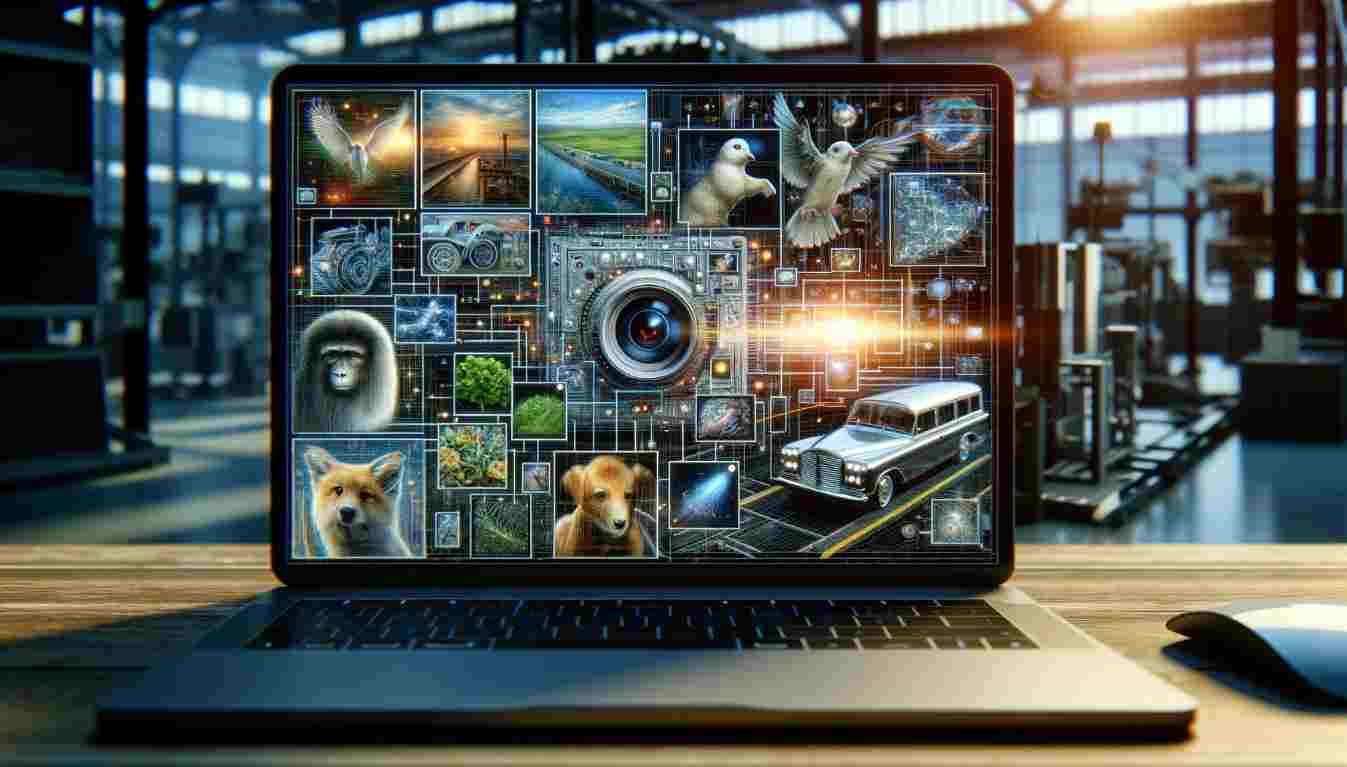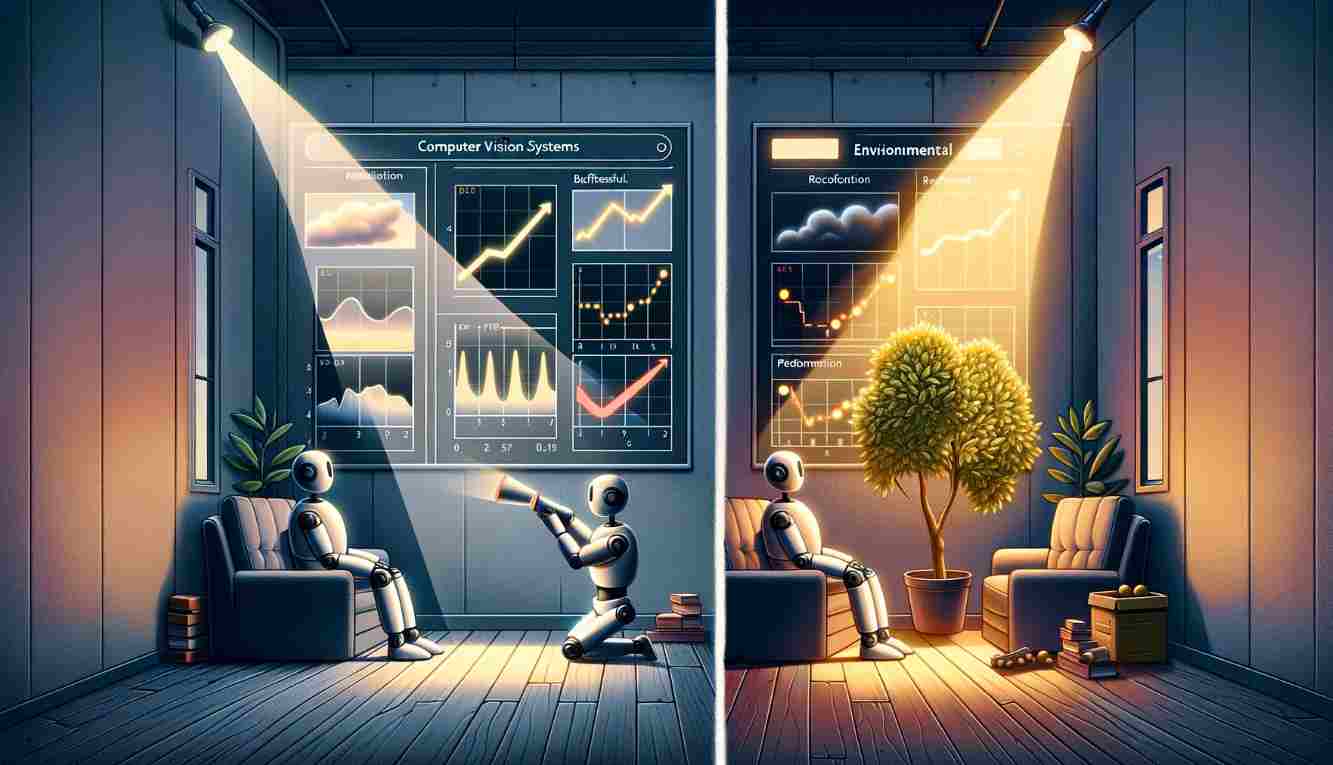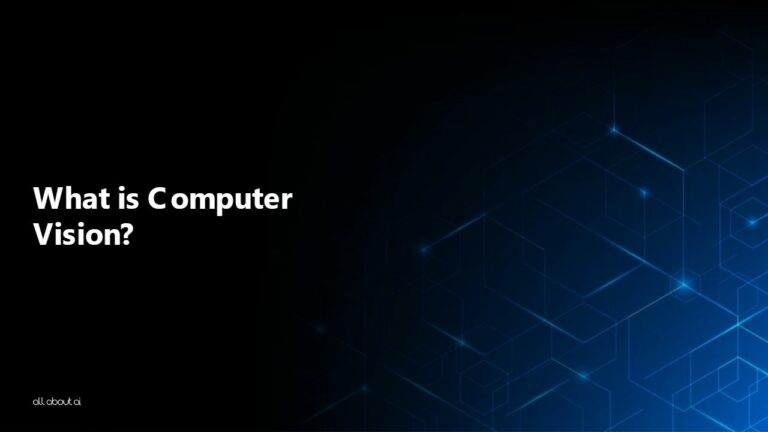Computer vision represents a significant branch of artificial intelligence (AI) that equips machines with the ability to interpret and comprehend the visual world. By extracting information from digital images or videos, computer vision systems mimic the complexity of human vision. This technology enables computers to perform a myriad of tasks, from simple object recognition to complex scene understanding, driving forward innovations across various fields.
In this article, we wil thoroughly discuss “What is Computer Vision?,” its evolutions, role in AI and machine learning and everything between. So what are you waiting for? Keep reading this article written by Machine Learning Specialists at allaboutai.com.
Teaching Computers to See: What is Computer Vision?
Computer vision is like teaching computers to see like humans do. It’s a part of artificial intelligence, which means making machines smart. Just like we look at pictures or watch videos to understand what’s happening, computers can do the same with computer vision. They learn to recognize different things, like a cat, a car, or even understand a whole picture, like what happens in a park. This helps computers do lots of cool things in many areas, making them super helpful for inventing new stuff.
What is Computer Vision? – The Evolution Journey
Now that you have understood the basic concept of “What is Computer Vision?” let’s review its evolution journey.
The journey of computer vision began in the 1960s, focusing initially on simple tasks such as digit and character recognition. Over the decades, it has evolved significantly:
1960s:
The foundational era, where the focus was on basic pattern recognition and establishing the groundwork for future research.

1970s-1980s:
Significant strides were made in developing algorithms for object detection, scene reconstruction, and optical character recognition, laying the foundation for modern computer vision.
1990s-2000s:
The introduction of machine learning techniques began to significantly enhance the capabilities of computer vision systems, leading to more sophisticated and accurate image and video analysis.
Technological advancements over the years
Technological innovations have propelled computer vision forward, particularly through the integration of artificial intelligence and machine learning:
Convolutional Neural Networks (CNNs):
This breakthrough in the late 1980s and subsequent advancements have revolutionized image recognition, making it possible to process and analyze images with remarkable accuracy.
Large-scale Image Datasets:
The creation and utilization of extensive image datasets have enabled the training of more powerful and efficient computer vision models.
Real-time Processing and Edge Computing:
Advances in computational hardware and algorithms have facilitated the real-time analysis of visual data, expanding the applicability of computer vision to time-sensitive tasks.
How Computer Vision Works?
Computer vision systems operate based on a series of interconnected principles and techniques that allow them to perceive and understand visual information:
Image Acquisition:
The first step involves capturing digital imagery through cameras or sensors, forming the basis for further analysis.
Feature Extraction:
This critical process involves identifying and extracting key attributes or features from images, such as edges, textures, or specific shapes, which are essential for recognizing patterns and objects.
Pattern Recognition:
Leveraging extracted features, computer vision algorithms classify and categorize objects within images, enabling the system to make sense of what it sees.

Role of AI and Machine Learning
The integration of artificial intelligence and machine learning has been instrumental in advancing computer vision:
Adaptive Learning:
These systems improve over time, learning from vast quantities of visual data to enhance their accuracy and efficiency in tasks like image classification and object detection.
Deep Learning Models:
Particularly, deep learning and convolutional neural networks have become foundational to computer vision, allowing for the analysis of complex images and videos with high precision.
Convolutional Neural Networks
Convolutional Neural Networks (CNNs) stand as a cornerstone of computer vision technology. These deep learning models process visual information in layers, each designed to recognize different aspects of an image.
Early layers might detect simple features like lines and edges, while deeper layers can identify complex objects and scenes. This hierarchical approach allows CNNs to understand visual data in a comprehensive and detailed manner, making them exceptionally effective for various computer vision tasks.
Applications Transforming Industries
Now that you understand “What is Computer Vision?” let’s learn about its application in different grounds.
Computer vision is revolutionizing industries by enhancing efficiency, accuracy, and innovation through its advanced image processing and analysis capabilities.
Healthcare: Medical Imaging and Diagnosis
Computer vision is revolutionizing healthcare, offering new levels of diagnostic precision and enabling innovative treatment approaches:
- Automated Disease Detection: Advanced algorithms analyze medical imagery, such as X-rays, MRIs, and CT scans, to detect diseases with greater accuracy and speed than traditional methods.
- Personalized Treatment Plans: Detailed analysis of medical images supports the development of customized treatment strategies, improving patient outcomes and care quality.
Agriculture: Crop Monitoring and Disease Detection
In agriculture, computer vision is enhancing efficiency and sustainability through advanced monitoring and management technologies:
- Precision Agriculture: Computer vision enables the detailed monitoring of crop health, growth, and yield, facilitating optimized agricultural practices and resource use.
- Early Disease Detection and Management: By identifying signs of disease and pests early, computer vision systems help in implementing timely interventions, reducing crop loss and improving productivity.
Security: Facial Recognition and Surveillance
Computer vision significantly bolsters security measures through enhanced monitoring and identification capabilities:
- Advanced Surveillance Systems: Automated analysis of video feeds from public and private spaces improves security monitoring, detecting suspicious activities in real-time.
- Facial Recognition Technology: This application provides accurate identification and verification solutions, supporting law enforcement, access control, and personal authentication processes.
Manufacturing: Quality Control and Automation
In the manufacturing sector, computer vision is key to ensuring product quality and streamlining production processes:
- Automated Quality Control: Real-time inspection of products on the production line using computer vision technologies ensures high-quality standards are maintained consistently.
- Manufacturing Automation: Computer vision facilitates the automation of various manufacturing tasks, from assembly line operations to packaging, enhancing efficiency and reducing the risk of human error.
Challenges of Computer Vision
Despite its advancements, computer vision technology faces several significant challenges:
Variability in Environmental Conditions
Computer vision systems’ performance can drastically vary with environmental changes such as lighting, perspective, and background. Achieving consistency across diverse conditions remains a significant technical challenge.

Interpretation of Complex Scenes
Deciphering complex scenes with overlapping objects and intricate interactions poses a substantial challenge for computer vision. It struggles to match human vision’s contextual understanding and depth perception.
Data Security and Privacy Concerns
The integration of computer vision in various sectors raises critical concerns about data security and privacy. Managing sensitive visual information responsibly is a paramount challenge.
High Computational Requirements
Computer vision technologies, especially those employing deep learning, demand extensive computational resources. This requirement limits their accessibility and scalability in resource-constrained environments.
Lack of Standardization and Bias in Training Data
The absence of standardized datasets and inherent biases in training materials compromise the fairness and effectiveness of computer vision applications, necessitating rigorous validation and diversification efforts.
Future Directions of Computer Vision
The future of computer vision is marked by promising directions and potential breakthroughs:
Integrated AI Systems
The integration of computer vision with broader AI systems is poised to offer deeper insights into visual data, enabling more sophisticated analyses and decision-making capabilities across various sectors.
Advancements in Edge Computing
Future developments in computer vision will likely emphasize the efficiency of algorithms and the miniaturization of hardware, facilitating local processing on edge devices for faster and more privacy-conscious applications.
Semantic and Contextual Understanding
Enhancing computer vision systems to comprehend the context and semantics of visual scenes promises to revolutionize how machines interact with and interpret the visual world, making them more intuitive and helpful.
Autonomous Systems and Robotics
The integration of computer vision into autonomous systems and robotics is expected to significantly advance, enabling more autonomous navigation, interaction, and decision-making in complex and dynamic environments.
Privacy-Preserving Techniques
As computer vision technologies become more embedded in daily life, developing methods that respect and preserve user privacy will be crucial. This includes advancements in encrypted computation and anonymization techniques.
Want to Read More? Explore These AI Glossaries!
Step into the world of artificial intelligence with our thoughtfully compiled glossaries. Whether you’re just starting out or already advanced, you’re sure to find new insights!
- What is Automata Theory?: Automata Theory explores abstract machines and their computational prowess.
- What is Automated Machine Learning?: Automated Machine Learning, often abbreviated as AutoML, is the utilization of automated tools and processes to automate the end-to-end process of machine learning model development, including data preprocessing, feature selection, model selection, hyperparameter tuning, and deployment.
- What is Automated Planning and Scheduling?: Automated planning and scheduling in AI refers to the process of using artificial intelligence techniques to optimize and automate the allocation of resources, tasks, and activities over time.
- What is Automated Reasoning?: Automated reasoning lies at the core of artificial intelligence, where the focus is on crafting systems that can independently navigate the realm of logical deductions and inferences.
- What is Autonomic Computing?: Autonomic computing, often referred to as self-managing or self-healing computing, is a concept within AI and computer science.
FAQs
Here are some of the most commonly asked questions about the topic other than “What is Computer Vision?”
Is computer vision an AI?
Which is an example of computer vision?
Is computer vision easy to learn?
What are the key technologies behind Computer Vision?
Conclusion
As we stand on the brink of unprecedented technological advancements, computer vision continues to play a crucial role in shaping the future. Its applications, spanning across healthcare, agriculture, security, and manufacturing, demonstrate its transformative potential.
In this article, we have discussed “What is Computer Vision?” in detail, along with all the necessary information related to it. To learn more about AI terminologies and concepts like these, do check out more articles in our AI Terminology Guide.





